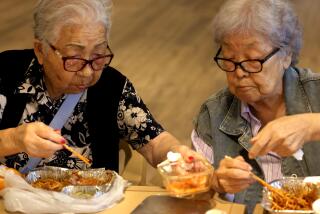Lost L.A.: Japanese village on Terminal Island had a short life
- Share via
This is a tale of Japanese survival in another tsunami, a riptide of social intolerance that took out a San Pedro neighborhood two generations ago.
The story begins in the 1860s when the first Japanese settled in Northern California. Relatives and friends followed from Hawaii. At the turn of the century, a Japanese fisherman discovered abalone in L.A. waters. He and his community drove deals with white cannery owners to build a life fishing and living in Santa Monica and San Pedro.
When discrimination simmered before the first World War, fishermen moved to Terminal Island, four and half barren square miles that had been mudflats between the Los Angeles and Long Beach ports. In their village, called Fish Harbor, immigrants and their children settled into one-story bungalows with muted red shingles. Efficient and affordable, they were houses for democracy, designed to accommodate any family. Front porches looked onto goldfish ponds and picket fence gardens. Streets were named Tuna, Mackerel and Sardine, with signs in Japanese. Before a wood bridge was built to the mainland, neighbors left their doors unlocked.
Working on shore and fishing at sea, islanders forged in quiet isolation a new life reconciling the good of two nations. They spoke a combination of Japanese and English. They played baseball and mastered judo. They celebrated Christmas and May 5, Boy’s Day, when bamboo poles outside houses flew carp kites signifying family members, the largest standing for the oldest son. The golden fish was a symbol of courage and endurance, qualities immigrants needed to survive.
Elsewhere, industrious Japanese shopkeepers, nurserymen and farmers prospered. But when white labor organized to claim a stake in the American dream hogged by the era’s industrialists, railroad builders and bankers, they excluded the Japanese. Federal acts and state laws diminished inalienable rights. In 1920, during a presidential election, California further restricted land ownership and leasehold by Japanese immigrants and their American-born children, considered “ineligible aliens.”
Nation magazine wrote at the time that our “traditional sense of fair play has been swept away in a ferment of race prejudice and campaign buncombe.” Xenophobia and power had fueled a perfect storm.
The Japanese community endured through business, cultural and religious groups. Here in L.A., they built Little Tokyo with shops, restaurants and lodging serving Angelenos of Japanese descent working as gardeners and servants. They grew strawberries in fields near Gardena and continued fishing along the coast.
In the 1930s, the winds of war rose, fanning the embers of racial hatred. Local and national officials attacked successful Japanese fishermen as security threats. After Japan’s Imperial Navy bombed Pearl Harbor in December 1941, the FBI evacuated Terminal Island. The following February, President Franklin Roosevelt signed the executive order sending all Japanese Americans to prison camps. The U.S. Navy leveled the bungalows at Fish Harbor where kites had fluttered in May.
Fire, rain, earthquakes and waves wipe out towns and cities. With support they can be rebuilt, with safer harbors and homes for families to thrive again. But no sea wall or jetty will stop a rising tide of injustice.
Watters’ past columns on historical homes and gardens as seen through the lens of contemporary culture are archived at latimes.com/lostla. Comments: [email protected]
More to Read
Sign up for Essential California
The most important California stories and recommendations in your inbox every morning.
You may occasionally receive promotional content from the Los Angeles Times.










